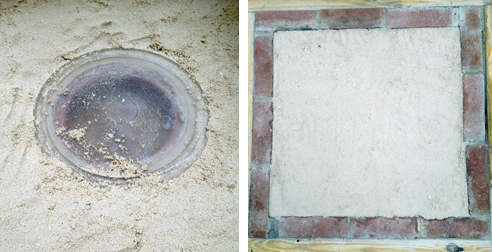The Muscat grapes and juice have fermented. My last specific gravity reading was 0.996. There are some grape skins still huddled around the top of the qvevri. Since our weather was turning sharply cooler, I decided to seal and cover the qvevri for the winter. Using a solution of potassium metabisulphite sprayed onto a paper towel, I carefully wiped the top of the qvevri and the part from the top to where the grapes skins were resting. I also cleaned and sanitized the glass covering. Kathy rolled a coil of clay that she put around the circumference of the qvevri opening. We loosely fitted the glass and inserted a small strainer holding a burning sulphur tab. We let it burn for awhile and the removed it and pressed the glass into the clay. One of the benefits of using glass as a covering is that we were able to see through the glass and see the clay. We knew where we needed to press a little harder to form a seal.

During fermentation, I sealed the qvevri with plexiglass with an airlock. During aging, I seal the qvevri with glass.
After the top was pressed into place, I poured about 2.7 cubic feet of play sand into the cavity. This covered the qvevri opening. After each bag of sand, I pressed the sand firmly. The qvevri top is several inches below the surface. Now we wait. I learned about patience in winemaking several years ago while making mead. It was cloudy and remained cloudy for several months. I read that it would take months and then it would clear up rather quickly. I waited and it did clear quickly about nine months later. I won’t have to wait that long to see what happens to the qvevri wine.
Our game plan is to open the qvevri in late March our early April. Our travel plans and the weather will have something to do with this. Between now and then, the wine and yeast, seeds and skins remain in the qvevri taking a long winter’s nap. If all goes correctly, when I open the qvevri the lees will have fallen first to the bottom of the qvevri. They will be covered by seeds and the the skins. The cloudy wine will have cleared. That is what happened to our qvevri wine we made in the country Georgia. While in Georgia, we did have wine from some qvevris that was still cloudy though. Unlike making wine in barrels or other winemaking vessels, I won’t be able to periodically test the wine in the buried qvevri. Perhaps this is where faith enters into the winemaking process.
Cheers,
Terry




I am amazed by this method of wine making. I have never seen this before and is this method the reason why Georgia has won many awards for their wine? I will look this up on google to understand this way-does this make a better wine? If yes, why? Thanks for sharing this with me.
Dorothy,
Georgia is winning awards for both their traditional qvevri wines and their modern European-style wines. The bulk of the wine produced is the European-style. Qvevri winemaking has survived because many people living in rural areas make it and have done so for thousands of years. Qvevri winemaking is the only winemaking process to be added to the UNESCO list of Intangible Cultural Heritage. People are beginning to learn about it. There is now a potter in Texas that went to Georgia to learn to make qvevri. He is now making them in Texas. If you want to learn more about Georgia, qvevri making and qvevri wine making, check out our book “Georgia, Sakartvelo: the Birthplace of Wine”. http://birthplaceofwine.winetrailtraveler.com